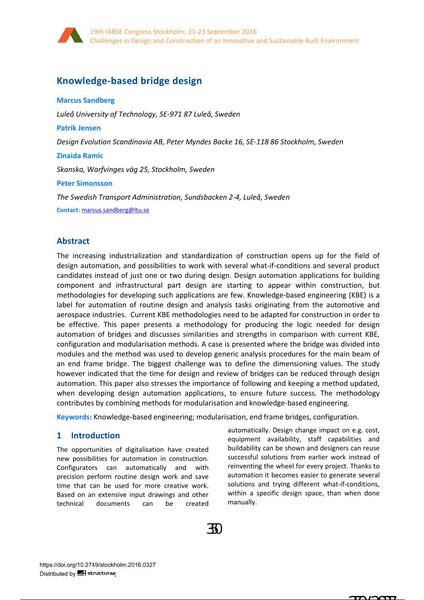Knowledge-based bridge design

|
|
|||||||||||
Détails bibliographiques
| Auteur(s): |
Marcus Sandberg
(Luleå University of Technology, SE-971 87 Luleå, Sweden)
Patrik Jensen (Design Evolution Scandinavia AB, Peter Myndes Backe 16, SE-118 86 Stockholm, Sweden) Ida Ramic (Skanska, Warfvinges väg 25, Stockholm, Sweden) Peter Simonsson (The Swedish Transport Administration, Sundsbacken 2-4, Luleå, Sweden) |
||||
|---|---|---|---|---|---|
| Médium: | papier de conférence | ||||
| Langue(s): | anglais | ||||
| Conférence: | IABSE Congress: Challenges in Design and Construction of an Innovative and Sustainable Built Environment, Stockholm, Sweden, 21-23 September 2016 | ||||
| Publié dans: | IABSE Congress Stockholm, 2016 | ||||
|
|||||
| Page(s): | 350-357 | ||||
| Nombre total de pages (du PDF): | 8 | ||||
| Année: | 2016 | ||||
| DOI: | 10.2749/stockholm.2016.0327 | ||||
| Abstrait: |
The increasing industrialization and standardization of construction opens up for the field of design automation, and possibilities to work with several what-if-conditions and several product candidates instead of just one or two during design. Design automation applications for building component and infrastructural part design are starting to appear within construction, but methodologies for developing such applications are few. Knowledge-based engineering (KBE) is a label for automation of routine design and analysis tasks originating from the automotive and aerospace industries. Current KBE methodologies need to be adapted for construction in order to be effective. This paper presents a methodology for producing the logic needed for design automation of bridges and discusses similarities and strengths in comparison with current KBE, configuration and modularisation methods. A case is presented where the bridge was divided into modules and the method was used to develop generic analysis procedures for the main beam of an end frame bridge. The biggest challenge was to define the dimensioning values. The study however indicated that the time for design and review of bridges can be reduced through design automation. This paper also stresses the importance of following and keeping a method updated, when developing design automation applications, to ensure future success. The methodology contributes by combining methods for modularisation and knowledge-based engineering. |
||||
